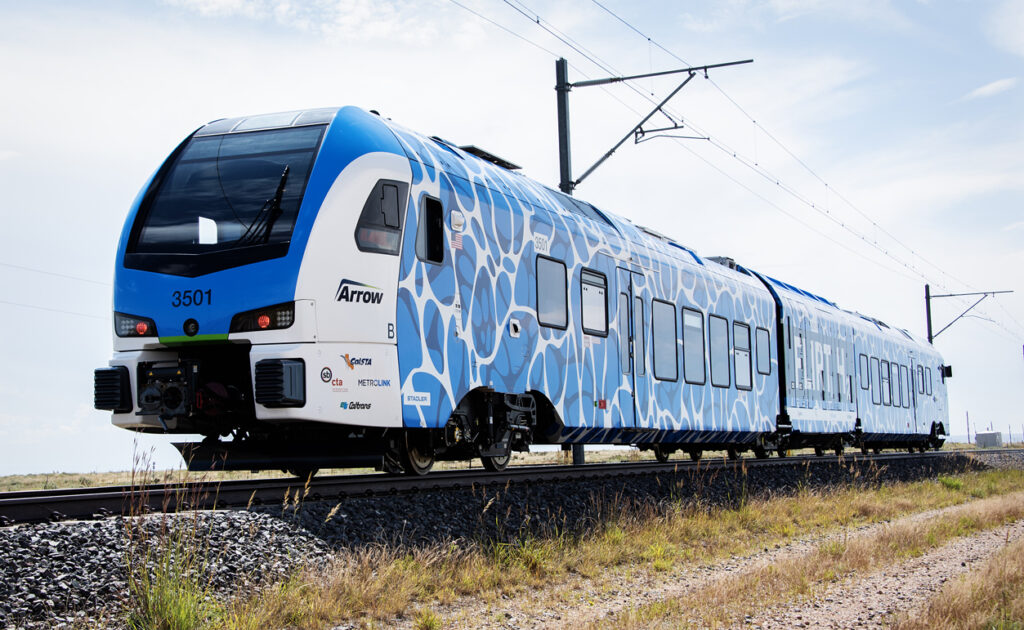All about the community of model railroading and rail enthusiasm
October 23, 2023
 News, Passenger Rail, Top News
News, Passenger Rail, Top News
Stadler presented its first hydrogen passenger train that will deliver to the San Bernardino County Transit Authority for the first time in the U.S. at APTA EXPO in Orlando earlier this month. The Swiss railcar maker followed by announcing an agreement for four hydrogen-powered trains, with an option to acquire up to 25 more, to be delivered to the California State Transportation agency (CalSTA) and Caltrans.
The FLIRT H2 for SBCTA is one of Stadler’s newest additions to its alternative drive portfolio and will start operations
in Southern California’s Inland Empire in 2024. The vehicle debuted at InnoTrans 2022.

The Zero-Emission Multiple Unit (ZEMU) is equipped with a modular power pack that is capable of powering a four-car train. Hydrogen technology is separated from the train’s passenger compartments.
The train has undergone extensive testing in Switzerland and the U.S. Successful trials led to an unprecedented decision by CalSTA and Caltrans to choose the train, Stadler Group said. The wheels began turning with the new Arrow Line – a nine-mile rail extension from Redlands to Metrolink’s popular San Bernardino Line.
SBCTA already deploys Stadler’s FLIRT diesel multiple unit (DMU) on the Redlands Line. In November 2019, the agency partnered with Stadler to design and build the first hydrogen-powered FLIRT.
The contract marked a key milestone for Stadler, as it played a significant part in the effort to bring zero emission technology to passenger rail in the U.S.
The FLIRT H2 consists of two electrically powered end-cars and a power pack in the middle. This power pack contains the fuel cells and hydrogen tanks. The fuel cells convert hydrogen into electricity, which is sent to a traction battery. The battery then supplies the drive of the vehicle with the power required at any given time.
The configuration also allows for recuperation of brake energy back to the battery. Therefore, the battery stores both braking power and power from the hydrogen cells.
The propulsion solution enables the FLIRT H2 to operate all day without re-fueling.
The train offers seating for 108 passengers and additional generous standing room. The maximum speed is 130 km/h (79 mph). Furthermore, the train is designed to handle operation in high ambient temperatures of up to 120 degrees Fahrenheit (49 degrees Celsius).
The contract with CalSTA and Caltrans will introduce a further developed SBCTA model with enhanced transport capacity. It demonstrates Caltrans’ commitment to invest in cutting-edge technology that will help California meet its ambitious zero-emission rail mandate.
Stadler Group representatives said the FLIRT H2 makes sense because very few rail lines in the U.S. are electrified.
“Our design of the battery fuel cell train is changing the U.S. rolling stock industry for alternative propulsion systems, combining the typical Stadler top quality and reliability,” Stadler US CEO Martin Ritter said. “We’re driving innovation that’s not just transforming railways, but the very essence of sustainable transportation in America.”
Stadler has been building trains, among them the energy-efficient FLIRT series, for over 80 years. The provider of mobility solutions in rail vehicle construction, service and signalling technology has its headquarters in Bussnang, Switzerland. It has a workforce of around 13,500 based in various production and engineering locations as well as more than 70 service locations.